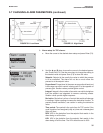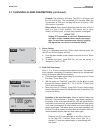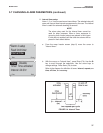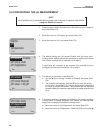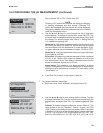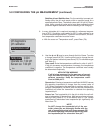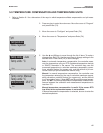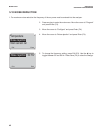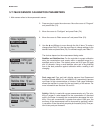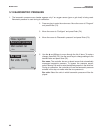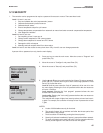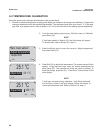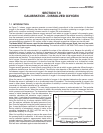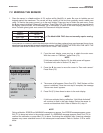
Stabilize : 0.050 ppm
Stabilize time: 10 sec
Exit Edit
Stabilize: 0.050 ppm
Stabilize time: 10 sec
Dual range cal : Disable
Exit Edit
Stabilize: 0.050 ppm
Stabilize time: 10 sec
Salinity : 0.0
o
/oo
Exit Edit
MODEL 54eA SECTION 5.0
SOFTWARE CONFIGURATION
5.11 MAIN SENSOR CALIBRATION PARAMETERS
1. Main sensor refers to the amperometric sensor.
Noise rejection
Main sensor cal
Security
Exit Enter
2. Press any key to enter the main menu. Move the cursor to "Program"
and press Enter (F4).
3. Move the cursor to "Configure" and press Enter (F4).
4. Move the cursor to "Main sensor cal" and press Enter (F4).
5. Use the é and ê keys to move through the list of items. To make a
change press Edit (F4). Use the arrow keys to change settings to the
desired value and press Save (F4). For allowed ranges, see Table 5-1.
The choices depend on the measurement being made.
Stabilize and Stabilize time: For the controller to accept calibration
data, the concentration must remain within a specified range for a
specified period of time. The default values are 0.05 ppm (50 ppb)
and 10 seconds. Using a small stabilize value and a long stabilize
time is the best protection against calibration while a reading is still
changing.
Dual range cal: Free and total chlorine sensors from Rosemount
Analytical (Model 499ACL-01 and 499ACL-02, respectively) become
non-linear at high concentrations of chlorine. Dual range calibration
allows the analyzer to correct for the non-linearity of the sensor. For
more information see Sections 8.0 and 9.0.
Salinity: Salinity is used with oxygen measurements only. The solu-
bility of oxygen in water depends on the concentration of dissolved
salts in the water. Increasing the concentration decreases the solu-
bility. If the salt concentration is greater than about 1000 ppm, the
accuracy of the measurement can be improved by applying a salini-
ty correction. Enter the salinity as parts per thousand (
o
/oo). One per-
cent is ten parts per thousand.
43



